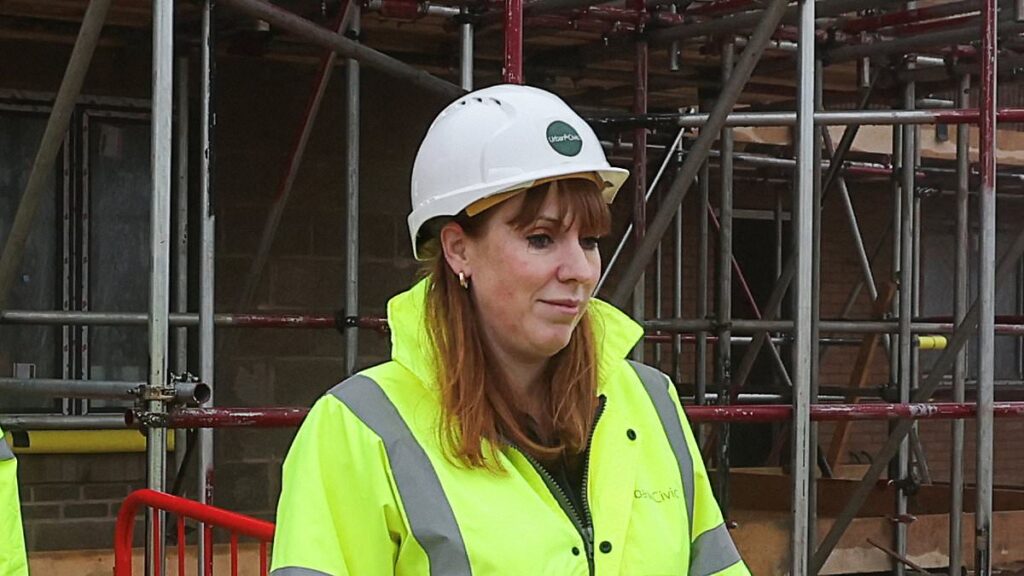Angela Rayner was accused of waging ‘war on rural England’ yesterday as she unveiled the biggest shake-up of planning rules for a generation.
The Housing Secretary’s blueprint included new demands for hundreds more developments in the Home Counties and fewer in the North.
MPs and campaigners warned that it paved the way for swathes of the Green Belt to be concreted over because it forces councils to re-classify thousands of acres into ‘Grey Belt’ sites for building on.
Other protections have also been diluted, with a vow to ‘safeguard the countryside from encroachment’ now dropped.
Councils that fail to submit detailed plans for achieving the steep targets, with some facing demands for a 2,000 per cent increase in building, could have developments imposed on them by Whitehall.
Two-thirds of councils have yet to submit fresh plans, creating fears of a flood of speculative planning applications by developers hoping their estates will be rammed through by officials eager to hit Labour’s new target of building at least 1.5million homes within this Parliament.
Local authorities have only three months to lodge fresh plans with the Government, even though they can take years to develop.
Under a shake-up intended to turbo-charge building to tackle the housing crisis and boost economic growth, some councils are facing demands for a seven-fold increase in the number of homes built every year.

Deputy Prime Minister Angela Rayner (pictured) was accused of waging ‘war on rural England’ yesterday as she unveiled the biggest shake-up of planning rules for a generation

Sir Keir Starmer (pictured) defended the changes during a visit to a construction site in Cambridge yesterday

The areas of the UK facing the biggest increases in building demands under Labour’s proposals
Sir Keir Starmer defended the changes during a visit to a construction site in Cambridge yesterday, saying getting people on the housing ladder was more important than protecting nature and the environment.
The Prime Minister added: ‘For years, we have not had enough houses being built. That means that individuals and families don’t have the security they want.’
Under the overhaul:
- On average, 370,000 homes must be built in England each year;
- Of these, 70,681 must be built in the South East – up from 69,000 when draft proposals were unveiled in the summer. In London, the target is nearly 88,000, much lower than the 98,800 set by the previous Tory government;
- Green Belt land that ‘does not strongly contribute’ to Green Belt purposes such as stopping urban sprawl should become Grey Belt;
- Any development on these sites must comply with new ‘golden rules’, such as requiring developers to build local infrastructure;
- The ‘golden rule’ of developments having to make 50 per cent of housing affordable was diluted to a minimum of 15 per cent;
- Councils must increase the land designated for traveller sites;
- Developments that appear to comply with a council’s local plan may not need to be signed off by councillors;
- Ministers will have the power to ram through developments in areas where councils have failed to submit comprehensive plans for reaching their annual target;
- Proposed fast-food and take-away shops within ‘walking distance’ of schools can be banned in certain areas.
Unveiling the overhaul to MPs, housing minister Matthew Pennycook insisted it included a ‘brownfield sites first’ approach to developments.
But he added: ‘We know that there simply are not enough sites on brownfield land registers to deliver the volume of homes the country needs each year.
‘We know that the changes required to start putting things right will be uncomfortable for some. But this Labour government will not duck the hard choices that must be confronted in order to tackle the housing crisis, because the alternative is a future in which a decent, safe, secure and affordable home is a privilege enjoyed by some rather than being the birthright of all working people.’
He warned that the Government ‘won’t hesitate to use the full range of ministerial intervention powers at our disposal’ to ram through developments if councils fail to play ball.
His Tory counterpart, Kevin Hollinrake, said he ‘welcomed’ the target of 1.5million homes, but added: ‘What we do not welcome is the war on rural England he is pursuing.
‘Following on from the family farm tax, the withdrawal of rural services delivery grants [which cover the additional costs of delivering services in remote areas], now we see the massive shift – mass house building in rural areas and on Green Belt.
‘We do not welcome the bulldozing of democratic accountability, we do not welcome the lowering of housing targets for urban areas and we do not welcome an average doubling – a 100 per cent increase [in developments] – for predominantly rural areas.
‘Residents will one day wake up to realise that they will face targets of up to 600 per cent increase. They will call their local councillor to ask them to oppose a specific application and be shocked at the response – ‘I’m sorry, we no longer have the right to vote against an individual application’.’

The Deputy PM revealed the collective total for local targets would be just over 370,000 homes a year – as she bids to deliver 1.5million new homes over the next five years
Former Tory deputy prime minister Sir Oliver Dowden said his rural Hertfordshire constituency was ‘almost entirely Green Belt’, adding: ‘This will mean massive new development, an expansion of London sprawl and a change in the character of the area for ever.’
Rebecca Paul, the Tory MP for Reigate, said the targets meant a 96 per increase in housebuilding for her Surrey constituency.
She said: ‘If all areas must play their part in building the homes we need, why is the minister reducing housing targets for London and other urban areas while increasing them in rural areas like mine?’
Roger Mortlock, of the Campaign to Protect Rural England, said: ‘Local authorities responsible for delivering new homes will be swamped with speculative applications on high-quality Green Belt and farm land. Inevitably, many of these will be approved to meet nationally imposed targets.’










